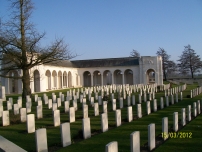| First Name: | Albert | Last Name: | COOMBER | |
|---|---|---|---|---|
| Date of Death: | 26/10/1914 | Lived/Born In: | Fulham | |
| Rank: | Private | Unit: | Royal Fusiliers4 | |
| Memorial Site: | Le Touret Memorial | |||
Current Information:Age-32 20, Querrin Street, Fulham
The Race to the Sea - September-October 1914 By the middle of September 1914, the Aisne battlefield had stagnated into trench warfare and in order to break this impasse, both sides tried to outflank each other in a general movement northwards. Moving up through Picardy, Artois and Flanders, the race was over by 19th October when the North Sea was reached. The Western Front, a line of trenches stretching from Belgium to Switzerland, was now a reality. Initially it was the French army that conducted this movement whilst the British Expeditionary Force remained on the Aisne but by 6 October British reinforcements were needed to help beat off German attacks around Lille. They moved north and along with reinforcements from Britain, they took up new positions in Flanders, on the left of the Allied line and much closer to the Channel ports. The battle of La Bassée This was fought by II Corps (3rd and 5th Divisions) between 10th October and 2nd November 1914 and as the name suggests it focused on an area around the town of La Bassée in northern France. It was part of the Race to the Sea and it determined the line of the Western Front in that sector. There were some initial British successes but La Bassée remained firmly in German hands. German reinforcements arrived and the village of Neuve Chapelle was captured by them. Towards the end of October, the fighting on this front died down as the attention of both armies switched to Ypres. At 4pm on 26th October, after a heavy and accurate artillery bombardment, the enemy launched a strong attack against the left of 5th Division and the right of 3rd Division near Neuve Chapelle. This sector was held by 1st Royal West Kent, 1st Wiltshire, 2nd Royal Irish Rifles and some of 4th Royal Fusiliers of 9 Brigade. They all suffered severely and some had to vacate their trenches because of the constant fall of heavy shells. 2nd Royal Irish Rifles were engaged in their third struggle in 24 hours and the number of those still in their line was reduced to 2 officers and 17 other ranks. Not surprisingly the line broke here and the Germans pressed through into Neuve Chapelle. 4th Royal Fusiliers and 1st Wiltshire on either side hung on. The reserve company of 1st Wiltshire, some 80 men, stopped the enemy at the western exits of Neuve Chappelle and drove them back into the burning village. During the evening other troops moved up and a counter attack was launched by the rest of 4th Royal Fusiliers plus the remaining companies of 1st Wiltshire and 2nd Royal Irish Rifles. They entered Neuve Chapelle and drove the Germans out but were unable to regain control of the old British trenches to the east of the village. The severe fighting resulted in many casualties including over two hundred from the ranks of 4th Royal Fusiliers, one of whom was Albert Coomber. |
||||
| « Back to Search Results | ||||
| If you think any of the information shown here is incorrect, Click Here to submit your amends and comments | ||||




